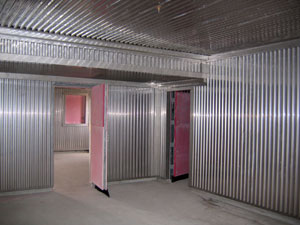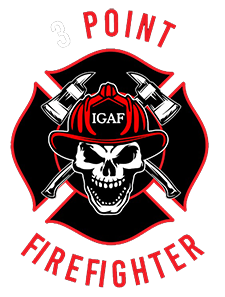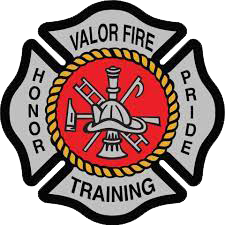WESTEC® INSULATION SYSTEM

Westec® is a unique two-part system that protects your training structure two ways. Outside, a strong stainless steel panel is tough enough to withstand the most strenuous training exercises. Inside, a Westec Insulation Blanket protects your tower from extreme temperatures during training. The innovative Westec Insulation System provides the highest level of protection-inside and out.
Westec’s rugged stainless steel panel offers a solid shield of protection. These rigid ribbed panels resist breaking, spalling, and cracking. This durability will significantly reduce maintenance costs and downtime.
The stainless steel panel is attached to a series of insulated steel channels. Under intense burn room heat, these specially designed channels flex, allowing panels to expand freely, without warping, to maintain system integrity.
Inside the system is a specially installed Westec blanket which provides a complete thermal break, the first of its kind! It won’t burn, singe, or break down even under the hottest conditions (blanket is stable up to 2300°F*). More importantly, it provides the highest level of thermal protection for your tower.
The Westec burn room insulation is the best system available for protecting your training structure and burn building. It reduces burn room maintenance costs, extends the life of the tower, and protects your investment. Westec is available in all new Fire Facilities fire training towers as well as a retrofit for existing buildings, whether steel, concrete, or masonry. Regardless of what type of tower you own, you can protect it better with the Westec Insulation System from Fire Facilities.
*For firefighter safety, Fire Facilities does not recommend training at temperatures in excess of 1200°F.
The Westec Insulating System is protected by US Patent 7,823,357 B2.
The Westec Insulation System is the first burn room insulation system designed to provide the best performance for all burn room conditions.
- High temperatures – The Westec Insulation Blanket withstands 2300°F* and the complete system withstands 1850°F* continuous temperatures.
- Thermal performance– Insulation properties of the Westec blanket are the highest and most stable in the industry. The system’s unique thermal break prevents heat from transferring through the system by conduction. See Cold Face Temperature Comparison
- Direct flame impingement – The Westec blanket is covered with stainless steel panels that can be exposed to direct flames without worry of damage.
- High-pressure hose stream – Westec’s stainless steel panels provide the most durable surface in the industry. They will withstand the direct pressure of a hose stream with no effect.
- Rust and corrosion resistance – Stainless steel panels and fasteners will not rust or corrode.
- Freezing cycles – Since none of the system’s components will absorb water, freezing is not a concern.
- Thermal expansion – Westec incorporates a unique system of structural supports, stainless steel panels, and flexible elements that allow the system to move with the heat rather than resist it. Therefore, the stainless steel panels will not warp from exposure to high temperatures.
- Resistance to impact – The stainless steel panels will withstand impacts far beyond those encountered in training scenarios.
- Warranted – Westec is the only insulation system supported by a 15-year warranty.
The Westec Insulation System consists of six basic components that are each designed to provide the critical elements of performance within a live fire.
- Framing system – Insulated steel channels are designed to resist all imposed loads while allowing the system to flex under thermal expansion.
- Westec Insulation Blanket – A 2″ thick blanket that is stable at temperatures up to 2300°F*. The blanket in unaffected by flame, heat, cold, or chemicals.
- Stainless steel panels – Type 304 stainless steel is formed into rigid panels and provides unparalleled protection against impact and water pressure damage. The formed panels allow for thermal expansion across the width of the panels which are installed to expand freely along their lengths without buckling.
- Thermal break – There are no screw penetrations between the framing system and the stainless steel panels, providing a complete thermal break. This barrier prevents the direct transfer of heat through the framing system to the building structure.
- Flexing and sliding connections – The connecting elements from the framing system to the stainless steel panels are made from Type 304 stainless steel and are individually designed to allow the walls and ceiling to expand freely across the length and width of the room.
- Corner guards – All outside corners, doors, and window openings are continuously protected with heavy Type 304 stainless steel corner guard angles.
*For firefighter safety, Fire Facilities does not recommend training at temperatures in excess of 1200°F.
Two-inch thick insulating blankets with a protective skin of stainless steel face panels are to be provided for the interior walls and ceiling for the burn areas (precut to length – field cut at door and window openings). The doors and window shutters shall be protected with a minimum of one-inch thick burn room insulating panels (precut to fit).
The insulating blankets shall be rated for 2300 degrees F. and shall be unaffected by the application of water. The insulation blankets shall not crack or break, shall be free from asbestos, and shall not produce toxic byproducts in the course of the intended use. The two-inch thick insulation blankets shall have a maximum K value of 0.74 at 1200 degrees F and 0.48 at 800 degrees F (please note – smaller K values denote better insulating values of the system).
The face panels shall have a 3/4″ maximum corrugation at 3-1/2″ on center to allow for lateral expansion when exposed to high temperatures. The base material, of the face panels, shall consist of type 304 stainless steel for corrosion protection and thermal performance at high temperatures. These panels shall attach to thermally protected channels with stainless steel screws. Stainless steel trims (type 304) shall protect all wall and door/shutter opening corners. All face screws exposed to fire shall be stainless steel and these screws shall not protrude through the backside of the insulating blanket (through screws are not permitted for maximum thermal protection).
The stainless steel face panels shall not be restrained from expanding at high temperatures, but rather the integral system shall be designed to accommodate the panel movements without creating any buckling or warping of the panels. All panels and trims shall be screw attached to allow for easy maintenance or inspection without disrupting the systems ability to move; welded panels are not allowed. Trims are to be designed to accommodate thermal expansion either through the use of slip connections or planned deformations.
Doors and window shutter insulation panels shall be pre treated water resistant, free from asbestos and shall not produce toxic byproducts in the course of the intended use. Insulation panels shall withstand a constant temperature of 1200 degrees F. and shall be unaffected by the application of water.
Temperature Summary
- Maximum safe training temperature for life safety is 1200 degrees F (continuous)
- Maximum service temperature for the insulation panels (doors and window shutters) is 1200 degrees F (continuous)
- Maximum service temperature of the wall and ceiling insulating system is 1850 degrees F (continuous)
- Maximum insulating blanket service temperature is 2300 degrees F (continuous)
Three temperature sensing devices/thermocouples are to be provided for the interior of each burn room. The thermocouples shall be grounded and consist of fiberglass insulated wiring with sealed stainless steel probes. Ceiling thermocouples shall protrude into the area perpendicular to the ceiling while all stainless steel encased wall thermocouples shall only run parallel to the walls for safety concerns.
314 Wilburn Road
Sun Prairie, WI 53590-9401
Contact Us - 1-800-929-3726









